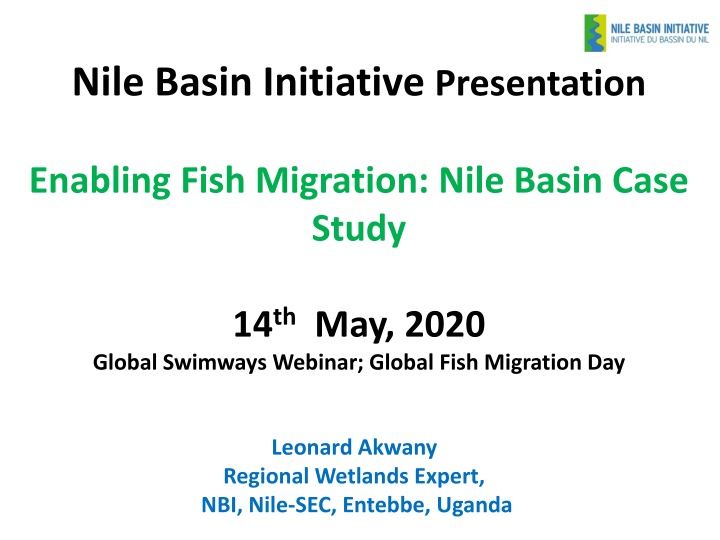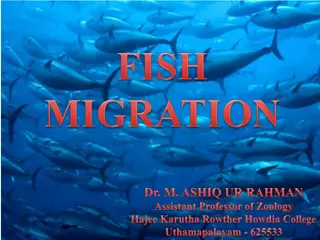Sustainable Development through Nile Basin Initiative: Focus on Fish Migration
Enabling fish migration in the Nile Basin through the Nile Basin Initiative is crucial for sustainable socio-economic development. The initiative aims to ensure equitable utilization of water resources, efficient water management, poverty eradication, and economic integration, benefiting the 11 countries in the basin. With a rich diversity of freshwater ecosystems and fisheries resources, promoting transboundary connectivity and mainstreaming fishery ecosystems in river basin planning are key priorities for ecological integrity and healthy fisheries in the region.
Download Presentation

Please find below an Image/Link to download the presentation.
The content on the website is provided AS IS for your information and personal use only. It may not be sold, licensed, or shared on other websites without obtaining consent from the author.If you encounter any issues during the download, it is possible that the publisher has removed the file from their server.
You are allowed to download the files provided on this website for personal or commercial use, subject to the condition that they are used lawfully. All files are the property of their respective owners.
The content on the website is provided AS IS for your information and personal use only. It may not be sold, licensed, or shared on other websites without obtaining consent from the author.
E N D
Presentation Transcript
Nile Basin Initiative Presentation Enabling Fish Migration: Nile Basin Case Study 14thMay, 2020 Global Swimways Webinar; Global Fish Migration Day Leonard Akwany Regional Wetlands Expert, NBI, Nile-SEC, Entebbe, Uganda
The Nile Basin Basic data: Area: 3.2 million km2 (in 11 countries) Length: 6695 km Population of basin countries 480 Mill Population in the basin 250 Mill 2
The TheNile Basin Initiative Nile Basin Initiative Launched on 22 February 1999 All except Eritrea are members of the Nile Basin Initiative (NBI) Egypt Eritrea Sudan Uganda Kenya DR Congo Ethiopia South Sudan Rwanda Burundi Tanzania 3
The Nile Basin Initiative Shared Vision Shared Vision Program Subsidiary Action Program Action on the ground Shared Vision: to achieve sustainable socio-economic development through equitable utilization of, and benefit from, the common Nile Basin water resources.
NBI Key Objectives, To; 1. Develop the water resources of the Nile Basin in a sustainable and equitable way to ensure prosperity, security, and peace for all its peoples. Facilitating Cooperation 2. Ensure efficient water management and the optimal use of the resources. Water Resource Management 3. Ensure cooperation and joint action between the riparian countries, seeking win-win gains. 4. Target poverty eradication and promote economic integration. Water Resource Development 5. Ensure that the program results in a move from planning to action.
Nile Basin and Fisheries Resources Nile Basin is rich and diverse in freshwater ecosystems e.g. Lake Victoria and its associated 25 rivers Fisheries associated ecosystem goods and services; Nutrition, Livelihoods, National Economies Imperative of Transboundary Connectivity for Ecological Integrity and healthy fisheries Imperative of fishery ecosystems mainstreaming in River Basin Planning and Development at Nile Basin or Sub-Basin Levels 6
Nile Basin Fish and Fisheries! Nile Basin has complex of freshwater ecosystems in terms of rivers, lakes and wetlands including Lake Victoria, Lake Kyoga, Lake Albert, Lake George, Lake Edward, Lake Tana, Sudd Wetlands, Nile Delta, White Nile, Blue Nile, Main Nile and associated complex of tributary rivers and lakes. Over 800 fish species, annual inland fish production of 1,503,429 Tonnes, aquaculture annual fish production of 1,228,352 Tonnes dominated by Egypt (El-Sayed AF.M. 2016) 7
Fish Migration Challenges/PLUS Water-related infrastructure; Dams, Multi-purpose water projects Catchments Deforestation and Heavy Sediments Loads/Siltation Habitat Fragmentation, Degradation and Loss Pollution, Eutrophication and Algal Bloom 8
Fish Migration Challenges/PLUS Invasive species e.g. Water hyacinth, Introduced Alien Fish Species Climate Change Inadequate or Diffused or Overlapping or Conflicting Governance Instruments Minimal Transboundary Collaborations Unsustainable fishing practices 9
Fisheries Wise-Use Framework Instruments The NBI Wetland Inventory (first inventory in 2009) Nile Basin Sustainability Framework (2011) The NBI Wetland Management Strategy (2013) The NBI Environmental and Social Policy (2013) NBI Climate Change Strategy (2013) The NBI Environmental Flow Strategy (2016) The NBI Water Resources Atlas (2016) Nile Basin Wetlands Atlas Next Environmental Sustainability Pillar of 2017-2027 NBI Strategic Plan (2017); Strategic direction 3.4 Improve fisheries and aquaculture production 10
Fisheries Wise-Use Actions Building Knowledgebase Environmental Flows Studies Transboundary Wetlands Management Plans Environmental and Social Safeguards for Investments Catchment Restoration and Management Fisheries Conservation Collaborations/ The Lake Edward and Albert Fisheries project Valuation of Ecosystem Services/Fisheries 11
Basin-Wide Engagement Platforms Regional Wetlands Working Group Nile Basin Wetlands Forum (1st and 2nd ) 12
Resource Portal for Reference Please Check on US: www.nilebasin.org http://nileis.nilebasin.org/content/wetlands http://nileis.nilebasin.org/content/environmental-and-social-policy http://nileis.nilebasin.org/system/files/23.10.13%20climate%20change% 20strategy.pdf Thank You 13























